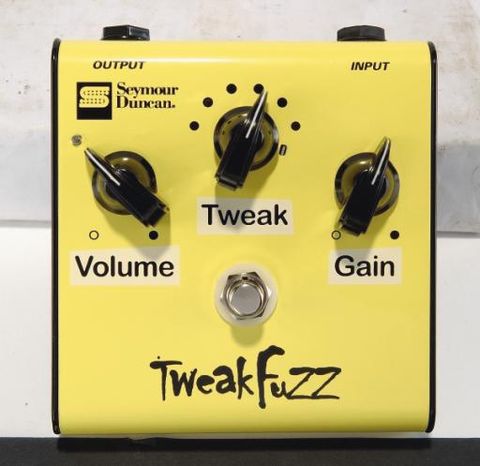Although mostly known as a giant of the pickup world, Seymour Duncan now has a couple of stompboxes in its product range. The SFX-02 Tweak Fuzz is the latest edition, and is produced in collaboration with Blues Saraceno.
You may only remember Blues from his brief career as one of Mike Varney's young hot shots on the Shrapnel label, but he's now a successful session player and his band project, Transmission OK, is also worth a listen.
The motivation behind the Tweak Fuzz is portability. Blues has been using high quality valve amps built by his father Alex for many years, but found them too bulky (and valuable) to lug to sessions. So he started investigating the possibility of using pedals to create his distortion sounds and, dissatisfied with those available, set his father to work again.
Slightly larger than the average stompbox, the Tweak Fuzz has three controls. Volume and gain are self-explanatory, but the 'tweak' control is the key to the unit's versatility.
This is a six-position rotary switch that allows you to select from a range of preset EQ resonance settings, which can radically change the character of your overdrive tone. The effect is similar to that of the resonance switch on Seymour Duncan's other pedal, the SFX-01 Pickup Booster.
The pedal features Class A circuitry and can be powered from either a 9V battery or DC adaptor (not supplied). The battery access isn't great - you have to remove four screws and take the whole casing apart.
The basic character of the Tweak Fuzz is reminiscent of a number of classic sixties fuzz pedals. You won't get a tight metal distortion out of it, but then there are plenty of pedals for that. Instead, the Tweak Fuzz is perfect for that spongy, compressed sound that you can only get from a proper fuzz pedal.
One of Blues Saraceno's criteria was that it shouldn't be a subtle pedal, and there's certainly plenty of distortion available. We did think it could do with a little extra boost, though; at a 50 per cent gain setting we needed to have the volume almost up full to get a decent level boost over the basic amp sound.
Tonal range
Despite that, the Tweak Fuzz is a lot of fun to use. The six Tweak settings cover a very wide tonal range; on a single-coil bridge pickup, the lowest (thinnest) setting will probably be too scratchy for most people, just as the thickest setting is probably a bit too bass-heavy for a lot of humbucker applications.
That doesn't rule out the possibility of using those combinations for special effect purposes though - even the most extreme sounds are perfectly pleasant to listen to. In between the two extremes, just about every permutation sounds good.
Combining a humbucking pickup with the lower settings sounds remarkably like an overdriven Fender Champ: great for early Freddie King impersonations.
On single-coils, the lower settings are ideal for choppy funky riffs. Whatever guitar you're using, the higher settings produce that rich, flutey overdrive sound typical of classic old fuzz pedals such as the Big Muff. It's not all about high gain and endless sustain though.
As Blues Saraceno shows on his video demo (see www.seymourduncan.com) the Tweak Fuzz also works well on relatively clean settings, providing some interesting EQ tweaks.
The Tweak Fuzz was quite a hit at NAMM and it's easy to see why. If you like thick, warm vintage fuzz sounds, it should definitely be high on your list of pedals to try. It's tonally quite versatile, and responds well to a variety of rigs and applications.
We'd have liked a little more potential for clean boost, but that was only really an issue at low gain settings. It's not quite in the crazy ZVex zone, but there ought to be enough fuzz for most people's tastes. The nearest equivalents we can think of are the Frantone pedals.
Considering the pedal's unique background, the price is extremely reasonable. It's a little more expensive than the big-name single-function units, but far, far cheaper than most of the luxury retro pedals out there.


